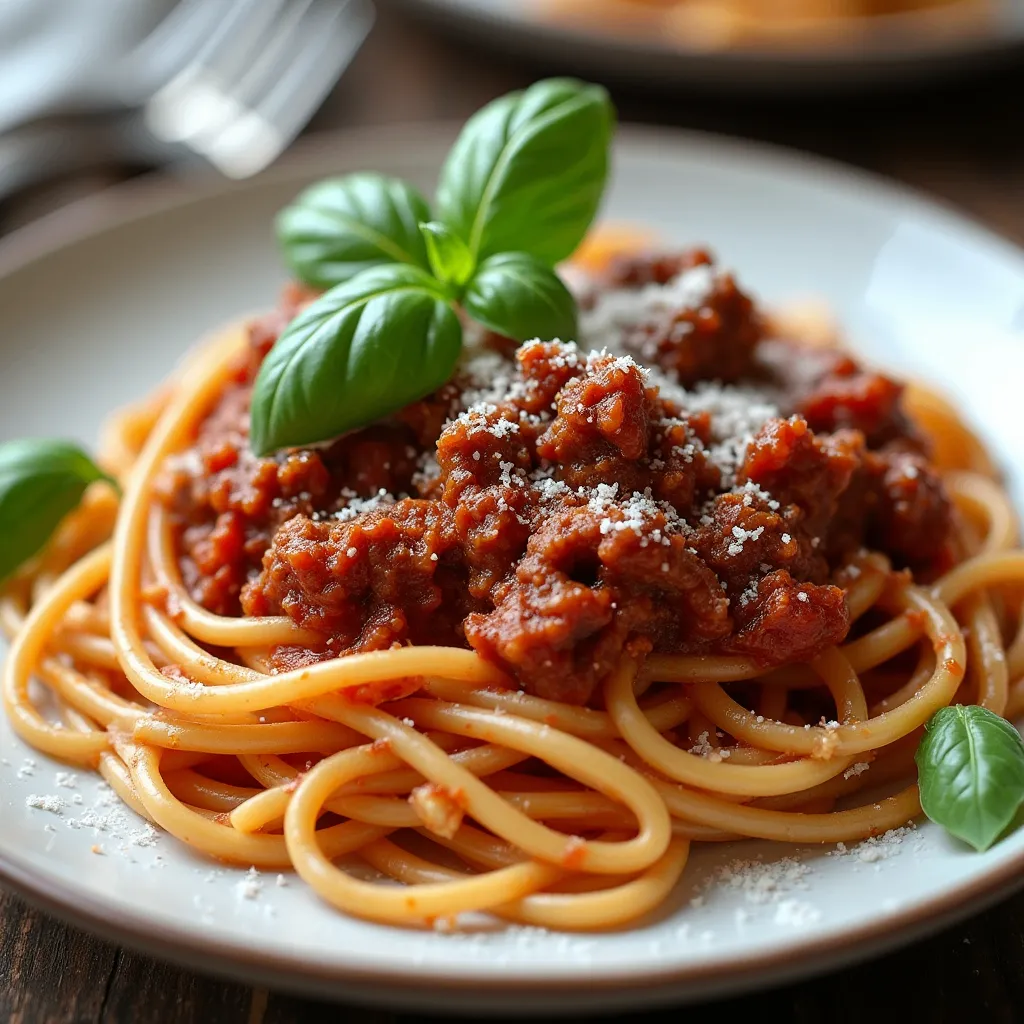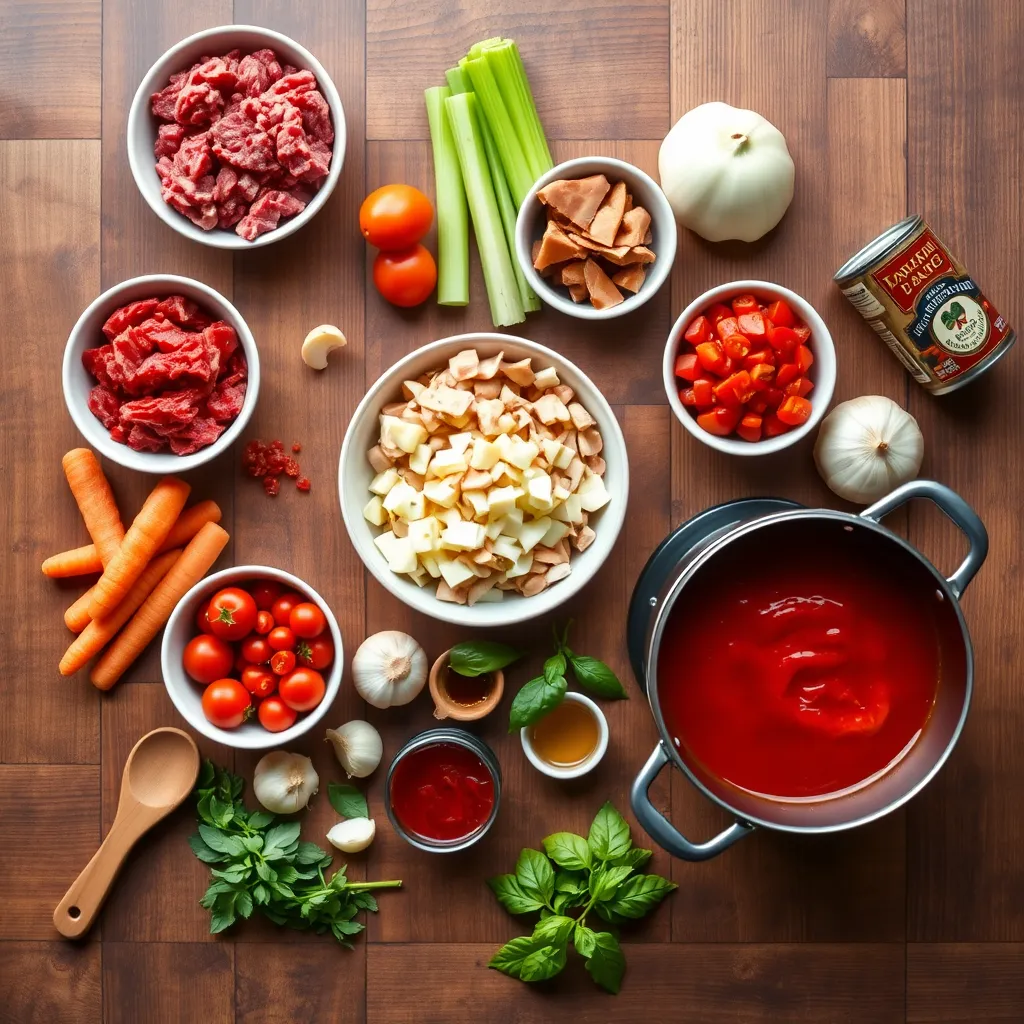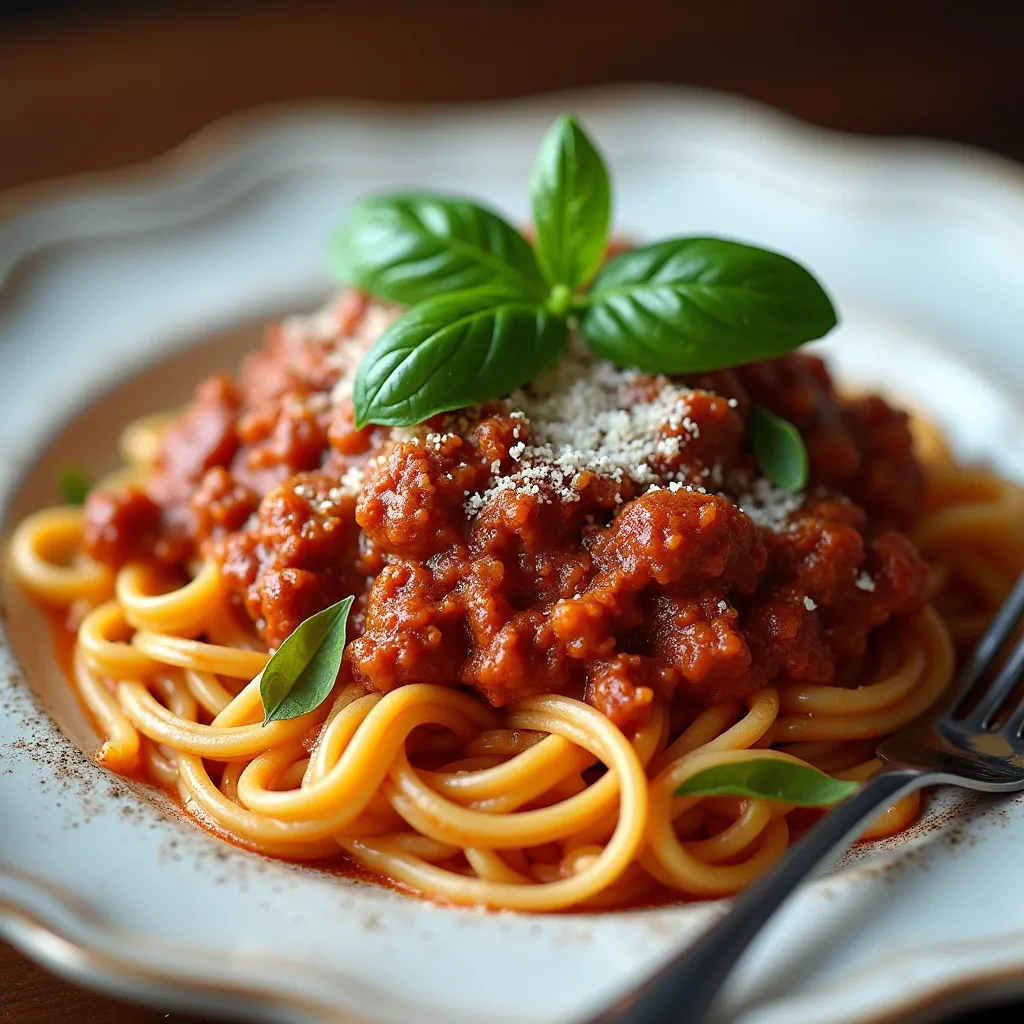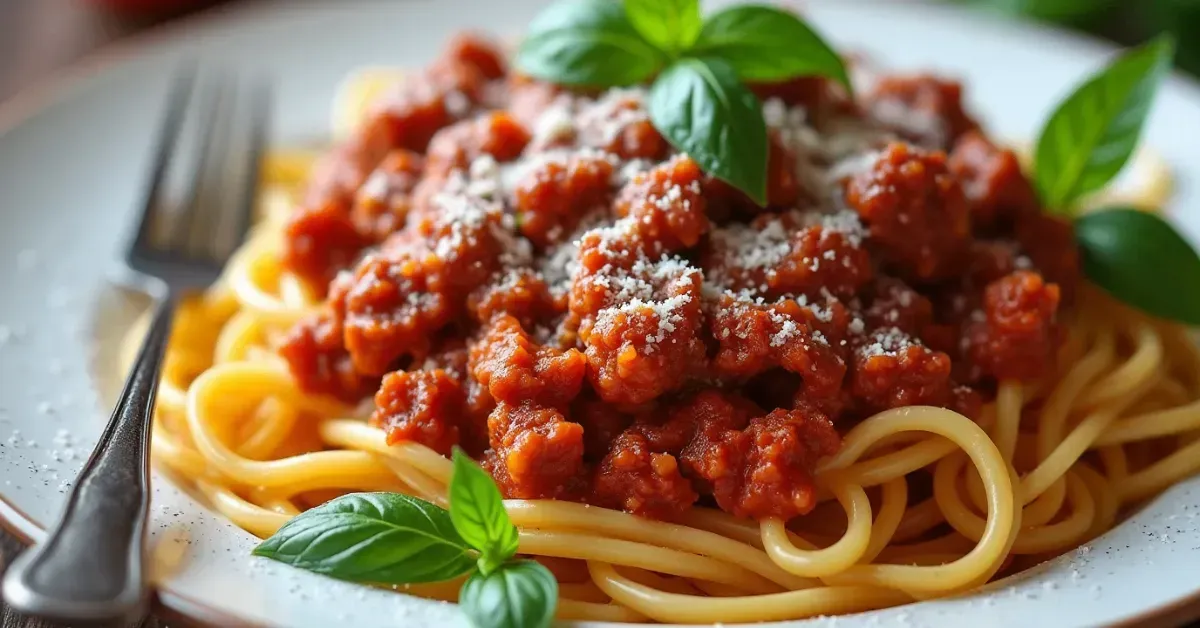Introduction
Bolognese sauce is a classic Italian dish known for its rich, slow-cooked flavors and hearty texture. Originating from Bologna, Italy, this meaty sauce is traditionally simmered for hours to develop deep, savory notes that perfectly complement pasta dishes. Unlike a simple tomato-based sauce, authentic Bolognese incorporates a blend of ground meat, tomatoes, wine, and aromatic vegetables to create a well-balanced and comforting meal.
In this guide, you’ll discover the best Bolognese sauce recipes, including step-by-step instructions, essential ingredients, and expert tips for achieving the perfect texture and depth of flavor. Whether you’re making a traditional version or a quicker alternative, this post will help you master the art of Bolognese sauce while exploring different variations and ideal pasta pairings.
Table of Contents
What Makes an Authentic Bolognese Sauce
Bolognese sauce, or ragù alla Bolognese, is a rich and hearty meat-based sauce that originates from Bologna, Italy. Unlike a basic tomato-based meat sauce, authentic Bolognese is slow-cooked and carefully layered with flavors, resulting in a thick, deeply savory dish that pairs best with wide pasta like tagliatelle.

Difference Between Bolognese and Traditional Meat Sauce
Many people confuse Bolognese sauce with a generic meat sauce, but they have distinct differences:
- Meat-to-Tomato Ratio – Bolognese has a higher meat content and uses just enough tomatoes to enhance the sauce, while traditional meat sauce tends to be more tomato-heavy.
- Cooking Method – Bolognese is slow-cooked for two to four hours to allow the flavors to develop, whereas a simple meat sauce can be made in under an hour.
- Ingredient Complexity – Bolognese includes pancetta, white or red wine, milk, and soffritto (onion, carrot, and celery), which are rarely found in basic meat sauces.
Essential Ingredients for a Rich and Savory Flavor
For an authentic and flavorful Bolognese, these key ingredients are essential:
- Ground Meat – A mix of ground beef and pork (or sometimes veal) provides depth and richness.
- Pancetta – Adds a subtle smokiness and enhances the umami flavors.
- San Marzano Tomatoes – These high-quality Italian tomatoes bring a natural sweetness and balanced acidity.
- Wine – Red or white wine deglazes the pan and infuses the sauce with depth.
- Milk or Cream – A small amount of dairy helps mellow acidity and create a silkier texture.
- Soffritto (Onion, Carrot, Celery) – This aromatic base gives the sauce a delicate sweetness and complexity.
- Tomato Paste – Intensifies the tomato flavor and contributes to the sauce’s thick consistency.
- Broth or Stock – Keeps the sauce moist during long cooking, adding even more depth.
Why Slow Cooking is Key for the Best Bolognese Sauce
Authentic Bolognese is never rushed. Simmering the sauce for at least two hours allows the flavors to fully develop and blend. Here’s why slow cooking makes a difference:
- Breaks Down Tough Proteins – Long cooking tenderizes the meat, making the sauce incredibly smooth.
- Enhances Flavor Integration – The gradual cooking process allows the meat, wine, tomatoes, and aromatics to combine harmoniously.
- Reduces Acidity – Slow cooking balances the acidity of tomatoes, resulting in a sweeter and richer sauce.
A well-made Bolognese sauce is all about patience. The longer it simmers, the better the taste, creating a sauce that’s both velvety and packed with deep, meaty flavors.
Classic Bolognese Sauce Recipe (Step-by-Step Guide)
A true Bolognese sauce is rich, thick, and full of deep, slow-cooked flavors. This traditional recipe follows the authentic Italian method, ensuring a perfectly balanced and savory dish that pairs beautifully with pasta.
Ingredients You’ll Need
To make a classic Bolognese sauce, gather these essential ingredients:
- 2 tablespoons olive oil – For sautéing the vegetables.
- 1 small onion, finely chopped – Adds a mild sweetness and depth.
- 1 carrot, finely chopped – Balances acidity with natural sweetness.
- 1 celery stalk, finely chopped – Enhances the aromatic base.
- 4 ounces pancetta, diced – Brings a smoky, rich flavor.
- 1 pound ground beef (80/20) and ground pork – A mix creates the best texture and taste.
- 2 tablespoons tomato paste – Deepens the tomato flavor.
- 1 cup dry red or white wine – Enhances complexity and balances richness.
- 1 cup whole milk or heavy cream – Helps tenderize the meat and adds a velvety texture.
- 1 can (28 ounces) San Marzano tomatoes, crushed – The best tomatoes for an authentic taste.
- 1 cup beef or chicken broth – Keeps the sauce moist during simmering.
- Salt and black pepper, to taste – Essential for seasoning.
- 1 teaspoon dried oregano or Italian seasoning – Adds extra depth.
- Parmesan cheese, for serving – Optional but enhances flavor when sprinkled on top.

Recipe Details
- Prep Time: 15 minutes
- Cook Time: 2 hours 30 minutes
- Total Time: 2 hours 45 minutes
- Servings: 6
- Yield: About 6 cups of sauce
Nutrition Facts (Per Serving) (Approximate values)
- Calories: 380
- Protein: 22g
- Carbohydrates: 12g
- Fat: 26g
- Saturated Fat: 9g
- Cholesterol: 70mg
- Sodium: 450mg
- Fiber: 3g
- Sugar: 6g
Key Features
✔ Authentic Italian recipe with rich, deep flavors
✔ Slow-cooked for maximum taste and perfect texture
✔ Versatile sauce – pairs with pasta, lasagna, or even polenta
✔ Meal-prep friendly – freezes well for later use
✔ Balanced flavors from wine, tomatoes, and aromatic vegetables
Step-by-Step Cooking Instructions
Step 1: Prepare the Base
- Warm the olive oil in a spacious pot on medium heat.
- Add the onion, carrot, and celery and cook for 5-7 minutes, stirring occasionally, until soft.
- Stir in the pancetta and cook until lightly browned.
Step 2: Brown the Meat
- Stir in the ground beef and pork, using a spoon to crumble the meat as it cooks.
- Cook for 6-8 minutes until browned and no longer pink.
- Season with salt and black pepper.
Step 3: Enhance the Flavor
- Add the tomato paste and cook for 1-2 minutes to enhance the flavor.
- Pour in the wine, scraping up any browned bits from the bottom of the pan. Let it simmer until reduced by half.
Step 4: Simmer the Sauce
- Add the crushed San Marzano tomatoes and broth, stirring well.
- Reduce the heat to low and let it simmer uncovered for 2-3 hours, stirring occasionally.
- Halfway through cooking, add the milk or heavy cream to soften acidity and create a creamy texture.
Step 5: Final Adjustments and Serving
- Taste the sauce and adjust seasoning if needed.
- Toss with cooked tagliatelle, pappardelle, or rigatoni, or use it for lasagna.
- Serve with freshly grated Parmesan cheese.
Tips for Enhancing the Flavor
- Use Red Wine for Depth – A dry red like Chianti or Merlot enhances the sauce’s richness, but white wine works well too.
- Simmer Slowly and Patiently – The longer it cooks, the better the flavor. A minimum of 2 hours is ideal.
- Stir Occasionally – Prevents the sauce from sticking and helps it develop a silky texture.
- Let It Rest Before Serving – Allowing the sauce to sit for 10-15 minutes off the heat helps flavors meld even further.
- Save Leftovers for Even Better Flavor – Bolognese tastes even better the next day, as the flavors continue to develop.

This classic Bolognese recipe is a labor of love, but the result is a deeply flavorful, authentic sauce that’s perfect for any pasta dish.
The Best Pasta Pairings for Bolognese Sauce
The right pasta can elevate a rich Bolognese sauce, providing the perfect base for this hearty, slow-cooked dish. While Bolognese sauce can work with a variety of pasta types, some pairings are considered more traditional and complementary than others. Let’s explore the best pasta choices and some variations you can try.
Tagliatelle vs. Spaghetti: Which One Works Best
- Tagliatelle – This wide, flat ribbon pasta is the traditional pairing for Bolognese sauce in Italy. Its wide surface area allows the sauce to cling perfectly, making each bite rich and satisfying.
- Spaghetti – While spaghetti is a popular pasta for many types of sauce, it’s often too thin for the hearty, chunky texture of Bolognese. It can still work, but it’s not the traditional choice.
- Best Choice – If you want an authentic experience, tagliatelle is your go-to pasta for Bolognese sauce. Its texture and shape help hold the sauce, making it ideal for creating the perfect bite.
Other Pasta Choices
If you’re looking to try different pasta shapes, here are some excellent alternatives:
- Pappardelle – A wide, flat pasta similar to tagliatelle, pappardelle provides even more surface area to catch the sauce. Its bold shape makes it an excellent option for a rich Bolognese.
- Rigatoni – These large, ridged tubes are perfect for holding onto a hearty meat sauce. The sauce fills the ridges, making each bite satisfying.
- Lasagna – For a comforting twist, you can layer Bolognese sauce with lasagna noodles to create a rich, baked dish that’s always a crowd-pleaser.
- Fusilli or Cavatappi – The twists and spirals of these pastas are great for grabbing sauce and making every bite flavorful.
How to Properly Toss Pasta with Bolognese Sauce
To achieve the perfect pasta and Bolognese combination:
- Cook your pasta until al dente, following the package instructions.
- Reserve 1 cup of pasta water before draining the pasta. This starchy water can help thicken and emulsify the sauce when added.
- In a large pan, heat the Bolognese sauce over medium heat. Add the cooked pasta and toss gently, adding a little reserved pasta water if needed to help the sauce coat the noodles evenly.
- Serve immediately, topped with freshly grated Parmesan cheese, for the ultimate Italian experience.
Quick and Easy Bolognese Variations
If you’re looking for a quicker way to make Bolognese sauce or need a healthier alternative, here are some great variations to try.
Instant Pot Bolognese – Fast and Flavorful in 30 Minutes
For a quick and flavorful Bolognese, the Instant Pot is your best friend. Here’s how to make it:
- Sauté the vegetables (onions, carrots, celery) and pancetta in the Instant Pot using the sauté function.
- Add ground meat, brown it, and then pour in wine to deglaze.
- Stir in tomato paste, crushed tomatoes, broth, and seasonings.
- Pressure cook on high for 20-25 minutes, followed by a natural pressure release.
- Stir in a bit of milk or cream at the end to balance the acidity.
This method gives you a rich Bolognese sauce in about 30 minutes.
Slow Cooker Bolognese – Let It Simmer All Day
For a slow-cooked version of Bolognese, use a slow cooker:
- Brown the meat and sauté the vegetables before adding them to the slow cooker.
- Add tomato paste, crushed tomatoes, and herbs.
- Set the slow cooker to low for 6-8 hours or high for 3-4 hours.
- Stir in milk or cream during the last 30 minutes to create a smooth, rich sauce.
The slow cooker method gives you a deep, flavorful sauce with minimal effort.
Healthy and Lighter Options (Turkey, Chicken, or Vegetarian Bolognese)
You can easily lighten up Bolognese sauce without sacrificing flavor:
- Ground Turkey or Chicken – These leaner meats are perfect for a lighter version of Bolognese. Simply substitute them for beef and pork, following the same recipe.
- Vegetarian Bolognese – Swap out the meat for lentils, mushrooms, or a combination of both. You’ll still get the hearty texture and savory flavor, but without the meat. Add some extra herbs and a splash of vegetable broth for depth.
These variations offer a health-conscious twist while maintaining the comfort and richness that Bolognese is known for.
Serving, Storing, and Reheating Bolognese Sauce
Bolognese sauce is a versatile dish that can be enjoyed in many ways, and knowing how to serve, store, and reheat it properly can make a huge difference in preserving its rich flavor. Here’s how to get the most out of your Bolognese sauce.
Best Toppings and Garnishes
When serving your Bolognese sauce, there are a few classic toppings that complement its richness:
- Parmesan Cheese – Freshly grated Parmigiano-Reggiano is a must for topping Bolognese. The salty, nutty flavor pairs perfectly with the savory sauce.
- Fresh Basil – Chopped fresh basil adds a refreshing herbal note and a pop of green color.
- Red Pepper Flakes – For a bit of heat, sprinkle some red pepper flakes on top. This adds a nice kick to balance the richness of the sauce.
- A Drizzle of Olive Oil – A touch of extra-virgin olive oil just before serving enhances the flavor and gives a silky finish.
These simple additions elevate the dish, making each bite even more delightful.
How to Store and Freeze Bolognese Sauce for Meal Prep
If you’ve made a large batch of Bolognese sauce and want to store it for later, follow these steps:
- Storing in the Refrigerator:
Allow the sauce to cool fully before storing it in an airtight container. Keep it refrigerated for up to 3-4 days for optimal freshness. When reheating, always stir and add a bit of water or broth if it thickens too much. - Freezing Bolognese Sauce:
Bolognese sauce freezes exceptionally well. To freeze:- Let the sauce cool completely.
- Divide the sauce into portions, depending on how much you need for a meal.
- Store the portions in freezer-safe containers or heavy-duty freezer bags, squeezing out any excess air.
- Label with the date and contents.
The sauce will stay fresh in the freezer for up to 3 months.
Freezing Bolognese is perfect for meal prep and allows you to enjoy the flavors of this dish at a later date without extra effort.
The Best Way to Reheat Without Losing Flavor
Reheating Bolognese sauce properly ensures that it retains its depth of flavor and smooth texture. Here’s how to do it:
- On the Stovetop:
Transfer the sauce to a pot over low heat. Stir frequently to prevent it from burning. If the sauce has thickened too much in the fridge or freezer, add a splash of water or broth to bring it back to the desired consistency.
For the best results, slowly reheat the sauce to allow the flavors to meld together again. - In the Microwave:
If you’re in a hurry, you can microwave individual portions. Place the sauce in a microwave-safe container and cover loosely. Heat in 30-second bursts, stirring between each interval to ensure the sauce warms evenly. Add a bit of liquid if needed to keep it from drying out. - Reheating from Frozen:
To reheat frozen Bolognese, the best method is to thaw it overnight in the refrigerator before reheating. If you’re short on time, you can defrost it in the microwave or heat it straight from frozen in a pot. Just make sure to stir frequently and add a bit of liquid to maintain the sauce’s consistency.
By following these methods, your Bolognese sauce will retain its flavor and texture, whether fresh or frozen.
Frequently Asked Questions (FAQ)
1. What is the difference between Bolognese sauce and regular spaghetti sauce?
Bolognese sauce, or ragù alla Bolognese, is a rich, slow-cooked meat sauce that typically includes ground beef, pork, and pancetta along with vegetables like onions, carrots, and celery. It’s cooked with tomatoes, wine, and sometimes milk or cream. Regular spaghetti sauce, on the other hand, is usually a tomato-based sauce with little or no meat and a quicker cooking time.
2. Can I make Bolognese sauce ahead of time?
Yes, Bolognese sauce is ideal for making ahead. Actually, the flavors develop and become richer as it sits. You can prepare it a day or two ahead, store it in the refrigerator, and simply reheat it when ready to serve. It also freezes very well for up to 3 months.
3. Can I substitute the meat in Bolognese sauce?
Absolutely! If you prefer a lighter version or a vegetarian option, you can substitute the meat with ground turkey, chicken, or even lentils for a plant-based version. You can also use a mix of mushrooms to create a vegetarian Bolognese.
4. How long should I simmer Bolognese sauce?
For the best results, Bolognese sauce should simmer for at least 2 to 3 hours. The longer it cooks, the deeper and more flavorful the sauce becomes. However, you can cook it for shorter periods if you’re in a rush, but low and slow is the key to achieving that rich, savory taste.
5. Can I use store-bought pasta for Bolognese sauce?
Yes, you can use any type of pasta to pair with Bolognese, though traditional choices include tagliatelle, pappardelle, or fettuccine. The wide, flat noodles are perfect for holding the thick sauce. If you’re using dried pasta, just make sure to cook it al dente so it doesn’t get mushy when combined with the sauce.
6. What should I serve with Bolognese sauce?
Bolognese sauce is often served with pasta, but it also pairs wonderfully with polenta or even used as a filling for lasagna. For a complete meal, consider serving it with a side of garlic bread and a fresh green salad.
7. How can I make my Bolognese sauce thicker?
If your sauce is too thin, let it simmer uncovered for a longer period to reduce and thicken. Alternatively, you can add a bit of tomato paste or a small amount of cornstarch mixed with water to thicken the sauce without compromising its flavor.
8. Can I use different types of tomatoes for Bolognese sauce?
While San Marzano tomatoes are the traditional choice for an authentic Bolognese, you can substitute with other high-quality canned tomatoes, such as Roma tomatoes. Just be sure to use a variety with good flavor and low acidity.
Pro Tips for a Perfect Bolognese Sauce
To make sure your Bolognese sauce turns out absolutely perfect every time, here are some expert tips:
- Use a Mix of Meats – For a richer, more complex flavor, try using a combination of ground beef, pork, and pancetta. The pork adds sweetness, while the pancetta gives a salty depth.
- Don’t Rush the Cooking – The secret to great Bolognese is slow cooking. Allow the sauce to simmer for at least 2 hours to develop a rich, deep flavor. The longer you cook it, the better it gets.
- Balance the Acidity – Add a splash of milk or cream at the end of cooking to mellow out the acidity of the tomatoes and balance the flavors.
- Use San Marzano Tomatoes – These tomatoes are known for their sweetness and low acidity, making them perfect for Bolognese. Canned San Marzano tomatoes will give you an authentic taste.
- Season Gradually – Season your sauce throughout the cooking process, adding salt and pepper at different stages. This allows the flavors to develop gradually and gives the sauce a better depth.
By following these tips, you’ll elevate your Bolognese sauce to a whole new level of flavor and authenticity.
You’ll Also Love
If you enjoy Bolognese sauce, here are some other delicious dishes to try:
- Lasagna – Layered with creamy béchamel, meat sauce, and cheese, lasagna is the perfect use for leftover Bolognese.
- Ragu alla Napoletana – Similar to Bolognese but with a rich tomato base, this hearty sauce pairs wonderfully with pasta like rigatoni or fusilli.
- Mushroom Ragù – A vegetarian alternative to Bolognese, this mushroom ragù is full of earthy flavors and perfect for pairing with pappardelle or tagliatelle.
- Spaghetti alla Carbonara – A classic Roman pasta dish made with eggs, cheese, pancetta, and pepper, it offers a rich, comforting contrast to the robust Bolognese.
These dishes are just as comforting and flavorful, making them the perfect next meal to try if you’re a fan of hearty, Italian-inspired cooking!
Conclusion
In conclusion, this Bolognese sauce recipe is a must-try for anyone who loves rich, savory, and comforting Italian flavors. With its slow-cooked, hearty ingredients and versatile pairing options, it’s the perfect sauce to elevate any pasta dish. Whether you stick to the classic recipe or experiment with variations like turkey or vegetarian Bolognese, you’re sure to create a meal that satisfies every time.
Don’t forget to share your delicious Bolognese sauce creations with us on Instagram using #BeesRecipes! We can’t wait to see how you make this timeless dish your own.
